Jasmeen & Amrit

Is this your first Sikh wedding?

Question
Is this your first Sikh wedding?
Answer
We are grateful to have so many friends and family with us on our wedding day. For some this may be the first time at a Sikh wedding and gurudwara (temple). So we decided to put together the key points of a Sikh wedding. We hope you find it helpful, and please contact the bride or groom with any questions.
Question
Dress code
Answer
For the religious wedding ceremony at the Sikh temple, formal and conservative attire is required. Our guests will be required to sit on the floor during the duration of the ceremony, so please wear pants or a dress that would allow you to do so comfortably. If you choose to wear a dress, please keep legs covered. If you are interested in wearing an Indian outfit, feel free to contact the Bride, Groom, or your Indian friends to borrow or to get help to purchase an Indian outfit.
Question
Covering your head/removing shoes
Answer
At the Sikh wedding ceremony both men and women will be required to cover their head and everyone is required to remove their shoes upon entry. There are plenty of shelves where your shoes can be stowed. Feel free to walk barefoot or in socks for your time at the temple. Gentlemen, you will be provided with a rumaal (bandana) or you may bring your own. Ballcaps and beanies are not considered acceptable types of headwear. Ladies, we ask that you bring a scarf or shawl, also referred to as a chunni or dupata, to cover your head and shoulders while you are at the temple.
Question
Milni (Meet and greet)
Answer
The bride’s family wait at the Gurudwara (temple) to greet the baraat (The Groom and his family and friends). When they arrive, family members meet, exchange garlands and embrace.
Question
Tea- served in the Langar hall
Answer
Tea and snacks will be served in the Langar hall. After everyone has eaten, you can make your way to Darbar Hall (main prayer room). In here, please make sure your head is covered and the women and men sit on their designated sides.
Question
Kirtan- Starting the ceremony with hymns
Answer
The Kirtania Jatha (religious singers) will be singing shabads (hymns). The sacred book, the Guru Granth Sahib will be attended by a sevadar (volunteer Sikh), and the groom will walk in and sit in front of it followed by the bride.
Question
Ardaas- The first prayer
Answer
The bride and groom and their parents will stand for the first prayer, which will be read out by the Gianni Ji (officiator). This seeks the blessing of the God for the marriage.
Question
Palla- symbolization of union
Answer
Before the beginning of the Anand Karaj (wedding ceremony), the bride’s father comes up to the couple and places the Palla (scarf) around the shoulder of the groom and hands the other end of the Palla to his daughter, signifying her acceptance and their union. Both bride and groom hold the ends of the Palla for the remainder of the ceremony. The Palla symbolizes the bond and commitment between the bride and groom.
Question
Anand Karaj (wedding ceremony)
Answer
Anand Karaj is the Sikh marriage ceremony. The term "Anand Karaj" translates to "Blissful Event" or "Ceremony of Joy." It involves the couple taking four rounds (called "Lavan") around the Guru Granth Sahib, the Sikh holy scripture, while prayers and hymns are recited. The ceremony emphasizes the spiritual union and equality of the partners. The four rounds, or "Lavan," in the Anand Karaj ceremony each have distinct spiritual meanings: 1. The first round signifies the couple's commitment to righteousness and the path of spirituality, emphasizing living a life of truth and following divine will. 2. The second Laav focuses on the growing love and devotion between the couple and to God, highlighting mutual support and understanding. 3. The third round represents detachment from worldly desires and a commitment to a life of service and humility, underscoring selflessness and dedication. 4. The fourth Laav signifies the attainment of spiritual bliss and eternal union with God, reflecting the culmination of the couple's spiritual journey together. After the final laav, the couple is considered husband and wife and the priest will offer a lesson.
Question
Ardaas- A final prayer
Answer
There is another Ardaas, and this time everyone is asked to stand and join in. A vak (verse) is chosen at random and recited for the benefit of everyone present at the wedding.
Question
Shagun- sweets and gifts
Answer
The parents of the bride and groom will bless the newly weds and offer them sweets and gifts/money. The bride and groom exchange flower garlands or wedding rings.
Question
Prashad (blessed offering)
Answer
At the end of the Wedding Ceremony, you will be given blessed food offering called 'karah prashad', which is made with flour, sugar and ghee (clarified butter). To respectfully receive parshad, remain seated and cup both hands together as the Priest approaches you. Parshad is very rich and buttery but don't worry, you will be provided a napkin. All guests, Sikh and non-Sikh are welcome to enjoy prashad. This is the end of the formal part of the Sikh ceremony. This will be followed by lunch in the Langar hall.